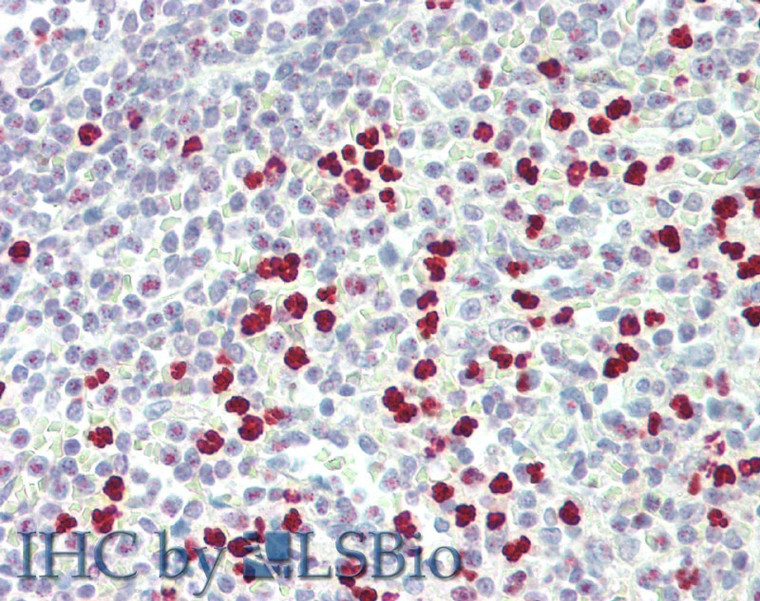| Host: |
Goat |
| Applications: |
Pep-ELISA/IF/IHC |
| Reactivity: |
Human |
| Note: |
STRICTLY FOR FURTHER SCIENTIFIC RESEARCH USE ONLY (RUO). MUST NOT TO BE USED IN DIAGNOSTIC OR THERAPEUTIC APPLICATIONS. |
| Short Description: |
Goat polyclonal antibody anti-PAD4/PADI4 (N-Term) is suitable for use in ELISA, Immunofluorescence and Immunohistochemistry research applications. |
| Clonality: |
Polyclonal |
| Conjugation: |
Unconjugated |
| Isotype: |
IgG |
| Formulation: |
0.5 mg/ml in Tris saline, 0.02% sodium azide, pH7.3 with 0.5% bovine serum albumin. NA |
| Purification: |
Purified from goat serum by ammonium sulphate precipitation followed by antigen affinity chromatography using the immunizing peptide. |
| Concentration: |
0.5 mg/mL |
| Dilution Range: |
IF-Strong expression of the protein seen in the nucleus of HeLa and U2OS cells. 10µg/mlELISA-antibody detection limit dilution 1:64000. |
| Storage Instruction: |
Store at-20°C on receipt and minimise freeze-thaw cycles. |
| Gene Symbol: |
PADI4 |
| Gene ID: |
23569 |
| Uniprot ID: |
PADI4_HUMAN |
| Immunogen Region: |
N-Term |
| Accession Number: |
NP_036519.2 |
| Immunogen Sequence: |
AQGTLIRVTPEQPC |
| Post Translational Modifications | Autocitrullination at Arg-372 and Arg-374 inactivates the enzyme. |
| Function | Catalyzes the citrullination/deimination of arginine residues of proteins such as histones, thereby playing a key role in histone code and regulation of stem cell maintenance. Citrullinates histone H1 at 'Arg-54' (to form H1R54ci), histone H3 at 'Arg-2', 'Arg-8', 'Arg-17' and/or 'Arg-26' (to form H3R2ci, H3R8ci, H3R17ci, H3R26ci, respectively) and histone H4 at 'Arg-3' (to form H4R3ci). Acts as a key regulator of stem cell maintenance by mediating citrullination of histone H1: citrullination of 'Arg-54' of histone H1 (H1R54ci) results in H1 displacement from chromatin and global chromatin decondensation, thereby promoting pluripotency and stem cell maintenance. Promotes profound chromatin decondensation during the innate immune response to infection in neutrophils by mediating formation of H1R54ci. Required for the formation of neutrophil extracellular traps (NETs).NETs are mainly composed of DNA fibers and are released by neutrophils to bind pathogens during inflammation. Citrullination of histone H3 prevents their methylation by CARM1 and HRMT1L2/PRMT1 and represses transcription. Citrullinates EP300/P300 at 'Arg-2142', which favors its interaction with NCOA2/GRIP1. |
| Protein Name | Protein-Arginine Deiminase Type-4Hl-60 PadPeptidylarginine Deiminase IvProtein-Arginine Deiminase Type Iv |
| Database Links | Reactome: R-HSA-3247509 |
| Cellular Localisation | CytoplasmNucleusCytoplasmic GranuleCytoplasmic Granules Of Eosinophils And Neutrophils |
| Alternative Antibody Names | Anti-Protein-Arginine Deiminase Type-4 antibodyAnti-Hl-60 Pad antibodyAnti-Peptidylarginine Deiminase Iv antibodyAnti-Protein-Arginine Deiminase Type Iv antibodyAnti-PADI4 antibodyAnti-PAD4 antibodyAnti-PADI5 antibodyAnti-PDI5 antibody |
Information sourced from Uniprot.org
12 months for antibodies. 6 months for ELISA Kits. Please see website T&Cs for further guidance









